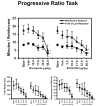Differential contributions of dopaminergic D1- and D2-like receptors to cognitive function in rhesus monkeys
- PMID: 16538469
- PMCID: PMC2099258
- DOI: 10.1007/s00213-006-0347-x
Differential contributions of dopaminergic D1- and D2-like receptors to cognitive function in rhesus monkeys
Abstract
Rationale: Dopaminergic neurotransmission is critically involved in many aspects of complex behavior and cognition beyond reward/reinforcement and motor function. Mental and behavioral disorders associated with major disruptions of dopamine neurotransmission, including schizophrenia, attention deficit/hyperactivity disorder, Parkinson's disease, Huntington's disease, and substance abuse produce constellations of neuropsychological deficits in learning, memory, and attention in addition to other defining symptoms.
Objective: To delineate the role dopaminergic D1- and D2-like receptor subtypes play in complex brain functions.
Materials and methods: Monkeys (N = 6) were trained on cognitive tests adapted from a human neuropsychological assessment battery (CAmbridge Neuropsychological Test Automated Battery). The battery included tests of spatial working memory (self-ordered spatial search task), visuo-spatial associative memory and learning (visuo-spatial paired associates learning task, vsPAL) and motivation (progressive ratio task, PR). Tests of motor function (bimanual motor skill task, BMS; rotating turntable task, RTT) were also included. The effects of the dopamine D2-like antagonist raclopride (10-56 microg/kg, i.m.) and the D1-like antagonist SCH23390 (SCH, 3.2-56 microg/kg, i.m.) on cognitive performance were then determined.
Results: Deficits on PR, RTT, and BMS performance were observed after both raclopride and SCH23390. Spatial working memory accuracy was reduced to a greater extent by raclopride than by SCH, which was unexpected, given prior reports on the involvement of D1 signaling for spatial working memory in monkeys. Deficits were observed on vsPAL performance after raclopride, but not after SCH23390.
Conclusions: The intriguing results suggest a greater contribution of D2- over D1-like receptors to both spatial working memory and object-location associative memory.
Figures





References
-
- Angeli SJ, Murray EA, Mishkin M. Hippocampectomized monkeys can remember one place but not two. Neuropsychologia. 1993;31:1021–30. - PubMed
-
- Arnsten AF, Cai JX, Murphy BL, Goldman-Rakic PS. Dopamine D1 receptor mechanisms in the cognitive performance of young adult and aged monkeys. Psychopharmacology (Berl) 1994;116:143–51. - PubMed
-
- Backman L, Robins-Wahlin TB, Lundin A, Ginovart N, Farde L. Cognitive deficits in Huntington’s disease are predicted by dopaminergic PET markers and brain volumes. Brain. 1997;120(Pt 12):2207–17. - PubMed
Publication types
MeSH terms
Substances
Grants and funding
LinkOut - more resources
Full Text Sources
Medical
Research Materials
Miscellaneous

